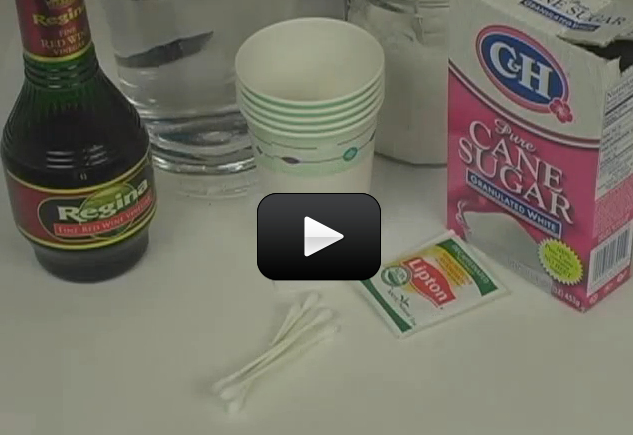The tongue has an ingenious design. Receptors responsible for getting information are separate and compartmentalized. So, different areas on the tongue actually have receptors for different types of tastes. This helps us to separate and enjoy the distinct flavors. In this experiment, you will be locating the receptors for sweet, sour, salty, and bitter on the tongue’s surface.
[am4show have=’p8;p9;p11;p38;p92;p29;p56;p81;p87;’ guest_error=’Guest error message’ user_error=’User error message’ ]
Here’s what you need
- 4 cotton swabs
- 5 wax cups
- 1 bag of black tea
- 1 bottle of red vinegar
- 2 packages of sugar
- 2 packages of salt
- 1 microwave
- water
- 1 spoon
- 1 partner
- 1 blindfold
Download Student Worksheet & Exercises
Here’s what you do
1. Put 3 ounces of water into the first of the wax cups. Bring it to a boil in the microwave and have an adult help you add a teabag. This will make your bitter cup. Let it sit for 5 minutes. While it is steeping, you can prepare the other cups.
2. Fill the remaining cups with 2 ounces of water each. Prepare them as follows:
A. For the sweet cup, add two packages of sugar to the warm water in one of the cups. Stir until well dissolved.
B. For the sour cup, add 2 ounces of red vinegar to another cup and stir well.
C. For the salty cup, put two packages of salt into the final cup. Stir until dissolved.
D. The last step in cup preparation is to discard the tea bag that has been steeping in the first cup.
3. Now put the blindfold on your partner and have them stick out their tongue. Dip the first swab into the tea. Using the diagram as a guide, swab each area one at a time: A, B, C, and D. Ask your partner to identify the flavors as sweet, sour, salty, bitter, or can’t tell as you swab each individual area. Record your partner’s response for each area.
4.Your partner should rinse out their mouth with water after testing the bitter tea. Then test each of the remaining solutions, one at a time in the same manner.
What’s going on?
Humans can identify thousands of distinct tastes, but we only have four types of taste receptors. When you take a bite of something flavorful, your saliva starts to dissolve it immediately. This solution of flavor and saliva goes to your taste buds and is then interpreted by your brain as sweet, sour, salty, or bitter.
The taste buds have taste receptors which bind to the structure of certain molecules: sweet receptors recognize hydroxyl groups (OH) in sugars, sour receptors find acids (H+, such as the citric acid in a lemon), salt receptors respond to metal ions (like Na+ in table salt), and bitter receptors are triggered by alkaloids. These are bases which contain nitrogen. It’s interesting to note the location of the bitter taste buds – they are on the back of the tongue. Since many poisons are alkaloids, their bitter taste may actually trigger vomiting.
Anyone who’s had a stuffy nose can tell you that smell plays a big role in our ability to taste. This makes sense because we know that we can only really taste the 4 distinct true flavors of sweet, sour, salty, and bitter. Our nose works in partnership with our tongue to allow us to identify more complex flavors.
Exercises
- How many different types of taste receptors do we have? What are they?
- Can you still taste food when you have a stuffy nose?
- Which taste receptors recognize the hydroxyl group?
[/am4show]
t6


Tongues really do have areas that are more sensitive to certain tastes, but the differences can be very subtle.
but there isn’t different tasting sections and all your taste buds can taste all of the five flavours